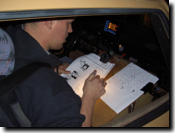ANR is a motorsport in Sweden, Denmark, Norway and Finland, Estonia and Åland. But with different rules and approaches to orienteering in every country.
![]()
There's also an FIA North European Zone Auto Navigation Championship.
The championship was earlier known as the Nordic Championship (of carorienteering). Four countries normally host one event each in an annual series of races – Denmark, Finland, Sweden and Norway.
Participating countries in NEZ are: Denmark, Norway, Sweden, Finland, Iceland, Estonia, Lithuania, Latvia and Russia.
The race
An event can be just a few special stages like the beginner ones shown in Quicktime on this page, or continue thruout the whole night with the longest races going on for eight to twelve hours or so, almost never any longer stops apart from half an hour rests halfway thru. In Finland they also arrange 24h races. Some transportation stages can occur in between stages, but very often a new stages follows directly after another. No waiting times, just racing! (In comparison to rally there most time seems to be waiting time and the last thing one does is racing...)
ANR is a bit like a mixture of enduro and normal orienteering, but with a thought out route that the arrangers has put togheter and kept secret from the competitors until they get to each of the stages starting point.
Controls
The orienteering is controlled by Time Controls, Orienteering Controls and Pass Thru Controls. The controls can be numbered in order, disorder or not numbered at all – it all depends on what type of competition the arrangers are holding. On an OC and PT there can be a capitol letter or a number that the co-driver signs in his Control-card depending on in wich country-rules you race by.
ANRs are normally held at evening or nighttime to raise the degree of difficulty, and to keep the competitions as safe as possible.

pic | A navigator reads the map-snippets, on the righthand side is the control code-noteboard.

Swedish ANR is normally held in forrest areas, military areas, industrial areas and often on- and off the roads/former roads in the countryside. But most parts of a race is on open, public roads and the normal road regulation laws apply aswell. The avarage speed is always max 30km/h.
There are a few variants of ANR in Sweden with TC, OC, PT's in Numbered order, Numbered but in disorder or No numbering at all. Includes ideal-timing, but one is always late to the finish!
The trick here is that we're using older maps with just the old roads on them. The orienteering skill is to relate the old map to the now present terrain – and guide the driver accordingly. All roads must be good enough and fit for driving, but we can spend much time clearing old roads free of the nature. We also use newly drawn maps with all roads present – mostly used at areas that change character often like a gravel pit – or at places that there's no other good maps available for us to use such as maybe at a farm or a racetrack.

A missed control is adding a 15 minute penalty.

This is a pass thru control.
Danish orienteering is a bit more tricky-orienteered (in my humble opinion) with lots of measuring a re-measuring before making the right decisions on where to go. In the Danish version one always can go ahead and get around the obstacles, but from the wrong direction – and with loss of time and missed checkpoints.
Very often a race can be held to some part in the middle of smaller cities or villages as well as in forests and field areas. Very tricky, but extremely rewarding for the co-driver as well when one figures out how to work it out. Includes ideal-timing, but again – we're always late to the finish!
The Danes now try to incorporate a few segments from the Swedish-rules to get a faster kind of racing... and some of the Swedes try to incorporate more of a Finnish-styled orienteering...
Finnish ANR is often very fast-orienteered. One follows a pre-printed GPS-like line – normally on a butter-paper like print which one is supposed to fit in on top on small map-snippets. One tricky bit is to do this properly so that one does the right road choices at the right lap in an area. But the organizers have improved their ANR-mapmaking procedure, and one can also find preprinted routs ontop of the maps in races more often nowadays.
Normally one goes around in small areas in sections, just to get back there later on to discover that one made the totally wrong choice just a few meters wrongly in that junction or around a tree just a few meters short. Includes ideal-timing and some time-calcutaions. Finland is just huge sand- and forest areas everywhere with some water in between. Lots of military areas as well, with more sand and trees. Great fun with a lot of the pressure on the drivers skill!
The controls are placed anywhere along the plotted route. Mostly pass-thru controls.
Norwegian orienteering usually includes a lot of time-calculating to match arrival times at stage finishes. NANR includes a lot of guessing when one from time to time goes in unmarked terrain for a specified amount of length starting in a specified direction. Some similarities to SANR, but with some own map-drawings on the co-driverside. Tricky indeed. But very pleasing for the co-driver to figure out the thoughts of the stage-makers.
Norwegian orienteering has changed quite a bit during the last few years, turning to be more fast orienteered, but the time-calculations and ideal timing are still in there since Norway's governing think motorsport is of the no good kind for their people.
Ålandish are nowadays very similar to the Swedish version. Just a few smaller differences.